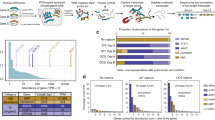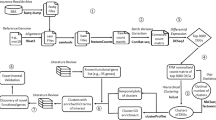Abstract
To test the hypothesis that the human genome project will uncover many genes not previously discovered by sequencing of expressed sequence tags (ESTs), we designed and produced a set of microarrays using probes based on open reading frames (ORFs) in 350 Mb of finished and draft human sequence. Our approach aims to identify all genes directly from genomic sequence by querying gene expression. We analysed genomic sequence with a suite of ORF prediction programs, selected approximately one ORF per gene, amplified the ORFs from genomic DNA and arrayed the amplicons onto treated glass slides. Of the first 10,000 arrayed ORFs, 31% are completely novel and 29% are similar, but not identical, to sequences in public databases. Approximately one-half of these are expressed in the tissues we queried by microarray. Subsequent verification by other techniques confirmed expression of several of the novel genes. Expressed sequence tags (ESTs) have yielded vast amounts of data1,2, but our results indicate that many genes in the human genome will only be found by genomic sequencing.
This is a preview of subscription content, access via your institution
Access options
Subscribe to this journal
Receive 12 print issues and online access
$209.00 per year
only $17.42 per issue
Buy this article
- Purchase on Springer Link
- Instant access to full article PDF
Prices may be subject to local taxes which are calculated during checkout



Similar content being viewed by others
References
Strausberg, R.L., Dahl, C.A. & Klausner, R.D. New opportunities for uncovering the molecular basis of cancer. Nature Genet. 15, 415–416 (1997).
Adams, M.D. et al. Initial assessment of human gene diversity and expression patterns based upon 83 million nucleotides of cDNA sequence. Nature 377, 3–174 ( 1995).
Uberbacher, E.C. & Mural, R.J. Locating protein-coding regions in human DNA sequnce by multiple sensor-neural network approach. Proc. Natl Acad. Sci. USA 88, 11261– 11265 (1991).
Solovyev, V.V., Salamov, A.A. & Lawrence, C.B. Predicting internal exons by oligonucleotide composition and discriminant analysis of spliceable open reading frames. Nucleic Acids Res. 22, 5156–5163 (1994).
Burset, M. & Guigó, R. Evaluation of gene structure prediction programs. Genomics 34, 353–367 (1996).
Ansari-Lari, M.A. et al. Comparative sequence analysis of the gene-rich cluster at human chromosome 12p13 and its syntenic region in mouse chromosome 6. Genome Res. 8, 29–40 ( 1998).
Worley, J. et al. A systems approach to fabricating and analyzing DNA microarrays . in Microarray Biochip Technnology (ed. Schena, M.) 65–86 (Biotechniques Books, Natick, Massachusetts, 2000).
Altschul, S.F. et al. Basic local alignment search tool. J. Mol. Biol. 215, 403–410 ( 1990).
Joshi, J.G., Fleming, J.T., Dhar, M. & Chauthaiwale, V. A novel ferritin heavy chain messenger ribonucleic acid in human brain. J. Neurol. Sci. 134, 52–56 (1995).
Dunham, I. et al. The DNA sequence of human chromosome 22. Nature 402, 489–495 ( 1999).
Heizmann, C.W. Ca2+−binding S100 proteins in the central nervous system. Neurochem. Res. 9, 1097–2000 (1999).
Wigge, P. & McMahon, H.T. The amphiphysin family of proteins and their role in endocytosis at the synapse. Trends Neurosci. 21, 339–344 ( 1998).
Millward, T.A., Zolnierowicz, S. & Hemmings, B.A. Regulation of protein kinase cascades by protein phosphatase 2A. Trends Biochem. Sci. 24, 186–191 (1999).
Ullrich, B. et al. Functional properties of multiple synaptotagmins in brain . Neuron 6, 1281–1291 (1994).
Acknowledgements
We thank D. Jenkins and other members of the ART team for assistance, support and encouragement; R. Thomas for programming assistance; Operon for cooperation on this project; and J. Graham for the use of DiCTion.
Author information
Authors and Affiliations
Corresponding author
Supplementary information
Rights and permissions
About this article
Cite this article
Penn, S., Rank, D., Hanzel, D. et al. Mining the human genome using microarrays of open reading frames. Nat Genet 26, 315–318 (2000). https://doi.org/10.1038/81613
Received:
Accepted:
Issue Date:
DOI: https://doi.org/10.1038/81613
This article is cited by
-
Biomedical vignette
Journal of Biomedical Science (2001)
-
Experimental annotation of the human genome using microarray technology
Nature (2001)



